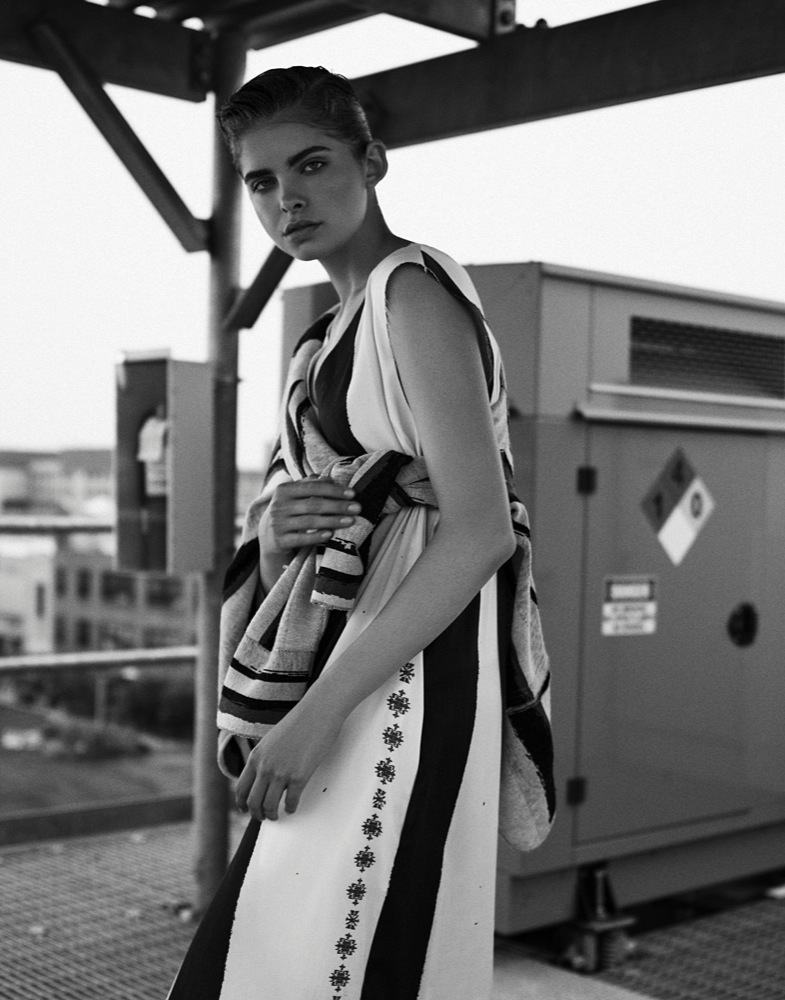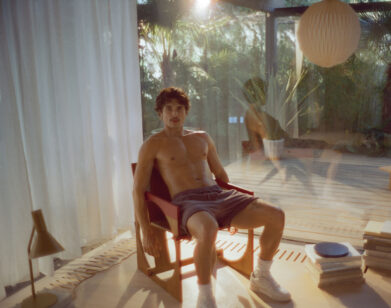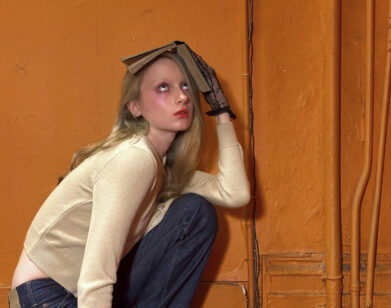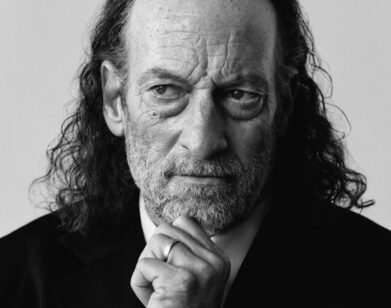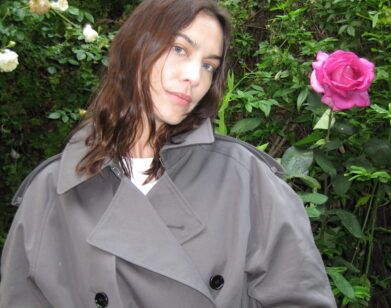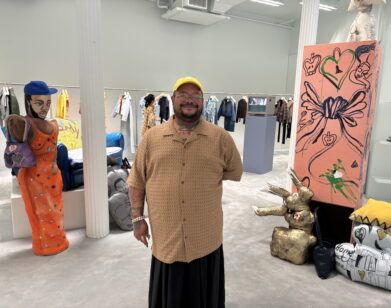Baja Babes
PHOTOS: HANS NEUMANN. STYLING: MARINA MUNOZ. MAKEUP: STEFANIE WILLMANN FOR SEE MANAGEMENT USING RMS BEAUTY. HAIR: WESLEY O’MEARA FOR HONEY ARTISTS. MODEL: SHAUGHNESSY BROWN/NEXT. STYLING ASSISTANT: ANITA LAU.
Scott Studenberg and John Targon founded Baja East less than two years ago in October of 2013 after working in sales at luxury labels like Lanvin and Céline. When you look at everything that has happened to the duo since then, however, it starts to feel like 10 years ago. Take the last six months: In February, the New York-based designers staged their second-ever runway show and were shortlisted for the LVMH Prize alongside Craig Green, Jacquemus, Huishan Zhang, XimonLee, and Koché. In June, Targon and Studenberg launched their first pop-up shop at Seaport Studios in New York. Just over two weeks ago, they were announced as one of the 10 finalists for the CFDA/Vogue Fashion Fund Award.
As gender lines blur both in and outside of fashion, it’s not suprising that Baja East has gained such a following. Inspired equally by California beachwear and urban streetwear (from New York to Tokyo via Berlin) and favoring sensual materials like leather and cashmere, Studenberg and Targon’s Baja East is boho-luxe for the 21st century; it can be soft and feminine, or musky and masculine depending on how you style it.
Here, Targon and Studenberg talk to their close friend, the model Jacquelyn Jablonski.
JACQUELYN JABLONSKI: It was fun running into you guys in Berlin. What brought you there besides the bratwurst and the hot men?
JOHN TARGON: I think it was the bratwurst on the hot men.
SCOTT STUDENBERG: Since our second season, the store in Berlin, which is housed in Soho House, has carried our collection. Now we are going into our seventh season—they’ve just placed their order for Resort 2016. It’s probably one of the most beautiful stores that we sell to. It’s more of a lifestyle store, which you saw. They have clothes but then they have a food area with gorgeous, healthy food that we like. John had been to Berlin before; I had never been. That was my first trip.
TARGON: We were brought there to do this trunk show and see the clients and show our resort collection, but we were also brought there because we’re inspired by street style and we enjoy nightlife. So it’s this mix and seeing how the city runs and feeding off of that creative energy and all of those vibes.
JABLONSKI: How did you first meet?
TARGON: We met at Equinox.
JABLONSKI: What was the first impression—good, bad?
STUDENBERG: I thought John was a bitch.
JABLONSKI: [laughs]
JABLONSKI: So you didn’t click right away?
TARGON: I don’t know if we didn’t click right away, but I am a bit more guarded. I think in general I have a little bit more to get through. But we started through a mutual friend—Josh—going to this class every Tuesday night and then getting Benny’s Burritos and margaritas and getting fucked up after doing this healthy abs and workout.
STUDENBERG: Because they had happy hour.
TARGON: And that’s all we could afford at that time.
STUDENBERG: How old were we? Were we 20?
TARGON: We were 20 or 21.
JABLONSKI: Well, tonight’s a Tuesday. Should we get Benny’s Burritos?
TARGON: We should.
STUDENBERG: We’re full circle back to the same pay scale.
TARGON: The luxuries of starting your own business.
JABLONSKI: Being friends that long and living together, do you have similar taste in boys? Do you fight over men?
STUDENBERG: There is a crossover in some things, but definitely John has different type.
TARGON: We do not fight over men. We have never had a fight over men. Maybe at different times we’ve hooked up with the same guy.
STUDENBERG: Yeah, we’ve hooked up with the same guys in the past—crossing over. But we have definitely never fought over the same guy.
TARGON: Let me put it this way: Scott always goes after my seconds.
JABLONSKI: Oooooooohhhh. [laughs] Sloppy seconds, damn!
STUDENBERG: That’s so not true.
TARGON: It is pretty true.
JABLONSKI: Burn. So, who’s the bad boy?
STUDENBERG: John’s bad. I’m not.
JABLONSKI: Interesting.
STUDENBERG: It’s a fact. Ask anyone.
TARGON: I think we equally like to stir up trouble. Where other things are very different for us—like our taste in men or even how we approach our collection—we both, at the end of the day, like to have fun.
STUDENBERG: We wanted to start our own brand, not only because we had a vision of what fashion could be and what wasn’t there, but also because we wanted to have fun. My past job was always fun; I learned a lot and I loved it. But Alber when I worked at Lanvin—you’ve done his shows before.
JABLONSKI: Yeah, he’s great.
STUDENBERG: He has a funny twist on things, never wants to be taken so seriously.
JABLONSKI: No, it’s always fun.
STUDENBERG: When he’s talking through the collection, it’s a very personal relationship with all the buyers, the editors, the models, and the people that work for the brand.
TARGON: I think if you talk about who’s “bad,” we both worked in the same industry and our schedules would overlap, and we somehow always found time to hang or do things, and I think it was that edge that made our jobs okay. Maybe that sounds terrible to say, but we always knew that we would link up and have a good time and experience the city for something other than work.
STUDENBERG: And we were still on point with our jobs.
JABLONSKI: What are some of the things you are really grateful you learned before going out on your own?
STUDENBERG: Our experience with sales and distribution, probably. We were just finalists in the LVMH Prize. We were talking to the other 25 designers, and they were so talented and so creative, and some of them were second season out of college. For us, we already knew the business side of it.
TARGON: We had a foundation.
STUDENBERG: We knew how to merchandise a collection, because we had done that at our past jobs with the design teams.
TARGON: I think we had a more pragmatic approach in many ways. We’ve learned not to take the lights in your office being on for granted. We’ve learned that all these things do not happen miraculously—the power behind what it actually takes to run something. It’s creative in the terms of our collection and what we’re pushing, but [we’re also conscious of] how we’re going to get by and pay people or not.
STUDENBERG: In our previous jobs, we didn’t just do sales and distribution—we weren’t just wholesale directors—we did a lot of things because we managed a business. Now, we’re managing our business. We were both able to multitask before and be very good at it, but now it’s that next level. We don’t have a janitor, so we’re cleaning up the dust on the floor. It’s not a sob story—any one who starts their own business has to do that. Neither of us are finance people, but somehow we have to be. John’s much better at that than I am. Those people I was talking about before—the creative talents and other designers—they may not have had a business approach, but they may know the right manufacturer or technical design and draping. Those are things that John and I are learning while they’re learning the business and sales and distribution.
TARGON: We’re learning how to push the creative side and what we can do.
STUDENBERG: But what we knew from the beginning that we could do was create a language for our brand. For instance, John and I both have these tattoos on our legs. [laughs]
JABLONSKI: What does it say?
TARGON AND STUDENBERG: Thriving.
JABLONSKI: Did you get them together?
TARGON: We did them in Austin. We were there for a trunk show and then we wanted to get tattoos. Maybe we’re both pretty bad…
JABLONSKI: You make bad decisions together.
STUDENBERG: No, we make great decisions.
TARGON: We run with our gut.
JABLONSKI: There you go. Speaking of tattoos, you have a palm tree?
STUDENBERG: Yeah.
JABLONSKI: And your Instagram name is “scottlovespalmtrees.” And you’re “johnlovespinecones.” When are you getting a pinecone?
TARGON: That’s the next one. We’re going to do it together.
STUDENBERG: I already have a palm tree, you want me to get another one?
TARGON: We’re just all going to get tattoos together.
JABLONSKI: I will not be getting one. But I will stand by; I will hold the Whispering Angel rosé…
TARGON: [laughs] Be a little less bad.
JABLONSKI: But seriously, why do you love pinecones?
TARGON: There’s a story that ties in.
STUDENBERG: I love the tall, skinny, thin palm trees in L.A. that you see in the distance or in San Diego. I always used to go to San Diego since I was a baby because I have family there. When John and I would travel for our jobs, I went to L.A. a lot, and every time I was out there I was like, “This is amazing! It’s always sunny. You see these beautiful palm trees, whether they’re lining a beautiful street in Beverly Hills or you’re driving on the freeway and you see them in the distance.” I always just got this happy feeling. When I started my Instagram, I was just like “I do not want to have another fucking boring Instagram name, like ‘jacquelynjablonski’…”
TARGON: [laughs]
JABLONSKI: What?!
TARGON: Mine was my name, but we were at this Halloween hayride in L.A., and someone ran up and said, “Oh, you’re ‘scottlovespalmtrees’!” and I was like, “No…”
STUDENBERG: “You need to get your eyes checked.”
TARGON: We look very different. [But] there was this pine trail, so I was like, “No, I’m ‘johnlovespinecones,'” and Scott was like, “change it immediately.”
JABLONSKI: I love it. It’s so random. What should I be? “Jacquelynloves…” what?
STUDENBERG and TARGON: Whispering Angel. [laughs]
JABLONSKI: [laughs] We’re really advertising that Whispering Angel.
TARGON: Please send the cases to…
JABLONSKI: I’ll make sure to change my account tonight. What’s the best part of being a design team? Is someone better at one thing or the other?
STUDENBERG: Yes. I can’t imagine doing it by myself, because you don’t have anyone to bounce ideas off of. How do know if your gut feeling is right? When I tell you things, maybe you don’t like something, and because you don’t like it, it’ll make me really think about if something is good or not. Then I’ll come back to you, and you’ll be like, “You’re right.” Or it’s totally a bad idea, and we’re both like, “No.”
TARGON: I think it’s just that. A lot of times Scott is loftier, and I pull back and think from a more minimal or less adventurous aesthetic. So we’re constantly pushing each other and then saying, “Okay, how are we going to meet in the middle?”
STUDENBERG: Sometimes it’s not even about the same style or silhouette—it’ll be about some styles that are a little bit more controlled and some styles that are a little bit more over the top, and the mix of those together. We’ve been working with Karen Kaiser since our second season, and she’s major.
JABLONSKI: We all love her.
TARGON: A lot of things that have come out the strongest for us are not the first thing that we do—we try something and then we go back and we’re both saying, “Okay, let’s push it this way, let’s do this.” It’s usually in that discussion, which at times can get heated or more passionate, that we come at things that end up working and have formed our brand DNA.
STUDENBERG: There have been times where we’ve almost strangled each other over zip pockets on a hoodie or something stupid like that. [laughs]
TARGON: It’s true.
JABLONSKI: Consumers and critics have reacted well to your label since its inception. Both coming from a background in wholesale, does Baja East’s design start as a reaction to the market’s demands, or are you demanding the market?
TARGON: It has completely shifted. Especially with our prints and the evolution of our collection, I hope that we are more and more demanding the market. With our first principles of being an ambisex brand for men and women, we set out to do something different. And not to toot our own horns, but now ambisex is coming down Prada’s runway; ambisex is coming down Gucci’s runway.
STUDENBERG: Saint Laurent.
TARGON: And not to say that we purveyed this, but we did in our inception and concept, make our brand genderless.
STUDENBERG: If you look at our first look book, I’m in half of the shots. I’m in a portion of the men’s model shots because our male model was late, and we’re just like, “We need to shoot.” We weren’t even shooting as a look book. We were shooting it as looks to send buyers.
TARGON: Because we never thought we had the budget for a look book.
STUDENBERG: We were just like, “Oh, we’ll have our friend come over and shoot looks,” which ended up being Georgia Hilmer, who we love and became friends with, and this one male model, who is probably sweet—I don’t know his name. He was late because he had just got a tattoo.
TARGON: We didn’t even have him take off the wrapping on it because we were like, “Oh, it’s kind of cool!”
STUDENBERG: But our first season had 25 styles max, so every single style went back and forth on a guy and a girl, and we shot it that way in the look book.
TARGON: I think in many ways we actually pushed that idea, and that didn’t come to us first thing. We were thinking, “Let’s go men’s” or, “Let’s go women’s,” and then we ended up saying, “Why does it have to be for one?”
STUDENBERG: We would go out wearing a baja before we started the brand, and our girlfriends would be like, “That’s so cute!” Or a djellaba from Marrakesh that we’d cut and tuck into our shorts and wear with Lanvin sneakers. Girls still wanted to wear those things; they thought it was quite cool.
JABLONSKI: I shop in the men’s section. Sometimes it’s just better.
STUDENBERG: I used to go into the J.Crew women’s section to find the deepest V I could…
JABLONSKI: That’s funny, because I go to J.Crew men’s for a big sweater.
STUDENBERG: But that sweater would fit you and you’d look amazing in it. [With the women’s sweaters], the sleeves were always three-quarter-length on me—very Audrey Hepburn—so I just had to roll them up completely as a short-sleeve cashmere sweater v-neck. We actually haven’t even done v-necks at Baja East yet.
JABLONSKI: Is that next season?
STUDENBERG: The baja is our v-neck. But we’re working on our eighth season now for Spring ’16, and those styles from our first season are still with us. They might not be in the same exact form, but that DNA is still there, whether it’s the message tee—
TARGON: Our ikat graffiti has been there since the first season.
STUDENBERG: Our baja shape, our boxing pant shape.
TARGON: And the whole idea of mixing these things that were more beach and street—we used this really supple leather with a fluffy cashmere. We still play very much in our collection with the mix of these fabrications.
STUDENBERG: But then the cashmere is in this ikat bohemian vibe, but it looks like graffiti. So it’s super luxe, but bohemian, but street.
TARGON: Identifiable.
STUDENBERG: We didn’t see anything like it on the market. We were looking online at men’s cashmere, and it was all grey or black or—
TARGON: —Boring.
STUDENBERG: So instead of just a black crewneck, it’ll be our ikat graffiti, but black and charcoal, so it has a print in it, but not everyone knows it’s there.
TARGON: We always play with, in each of our collections, this twist on a neutral palette. And we mix it back to our more vibrant, fun prints and colors.
JABLONSKI: Do you use mood boards? If so, what’s on your mood board for Spring 2016?
STUDENBERG: We definitely don’t. We start designing before we make our mood boards. It’s a process as we’re going because we’re always building on the past and our experiences—whether they’re reading a magazine or flying to Japan or being at a trunk show at Hirshleifers in Long Island and talking to 10 different women who are actual customers, or at Maxfield talking to the guys who are buying our stuff. It’s all those experiences plus things we’ve seen on the street. John’s more inspired by fine art. I remember when we were in Tokyo, I was freaking out. Not that I loved everything for our brand, but I was just so overwhelmed with all of the fashions. Even in Berlin, we were at [the nightclub] Berghain. They put stickers on both sides of your phone so you can’t take selfies or photos of other people, and they’re so scary when you walk in that you are frightened to take the stickers off, but all I wanted to do was take a photo of everyone there. We saw this one girl—she was so fucking major. She had a nose ring connected to her ears and all these tattoos everywhere and she was gorgeous. Some people there looked heinous and ratchet, but others looked like badass Berlin—like, “I’m coming for you”—and she was one of them. She basically took an entire pair of overalls and cut and cropped them as a crop top. She cut the entire thing off. So it was overalls, nipple, and I couldn’t focus on the bottom because of what she was wearing on the top. But I was freaking out because overalls were already in our Spring 2016 collection, but we were like, “Let’s make a top out of it!”
TARGON: We always put up inspiring images—we’re referencing a color palette or something from the things that stimulate us— but we’re often working in reverse because it’s so interactive in terms of the process. We’re not six months ahead like other designers, or even three months ahead, we’re often working in the real time to get something out just a couple months later. So it’s this ever-working mood board.
JABLONSKI: Do you ever get design block? How do you get over it?
STUDENBERG: It’s so funny. I remember when I went to FIT, I was on the phone with my dad one time. He doesn’t really know about fashion—he lives in Michigan—but I remember this conversation we had. He’s like, “Marc Jacobs is really rich. He’s a big business. Maybe you should consider fashion design.” And I’m like, “No, Dad, I cannot do fashion design. I don’t want to sit there and learn how to drape. I’m going to run out of ideas at some point, and that’s really stressful.” How can you keep building something? Maybe it’s because there are two of us, but I don’t think that we’ve run out of ideas. We haven’t faced blocks yet. We’re absorbing.
TARGON: Right now, we have a good flow of thoughts and ideas and directions. But things like a Berlin trip help in our inspiration. We went to Tel Aviv one time after our last runway show.
STUDENBERG: That was Spring 2015.
TARGON: And it inspired our color palette, it inspired how we felt.
STUDENBERG: It kind of confirmed out color palette. We had already been talking about red and blues and then, for Spring 2016, when we were in Florence, all we saw were these red flowers against the pool at the Four Seasons.
FOR MORE ON BAJA EAST, VISIT THE LABEL’S WEBSITE.

